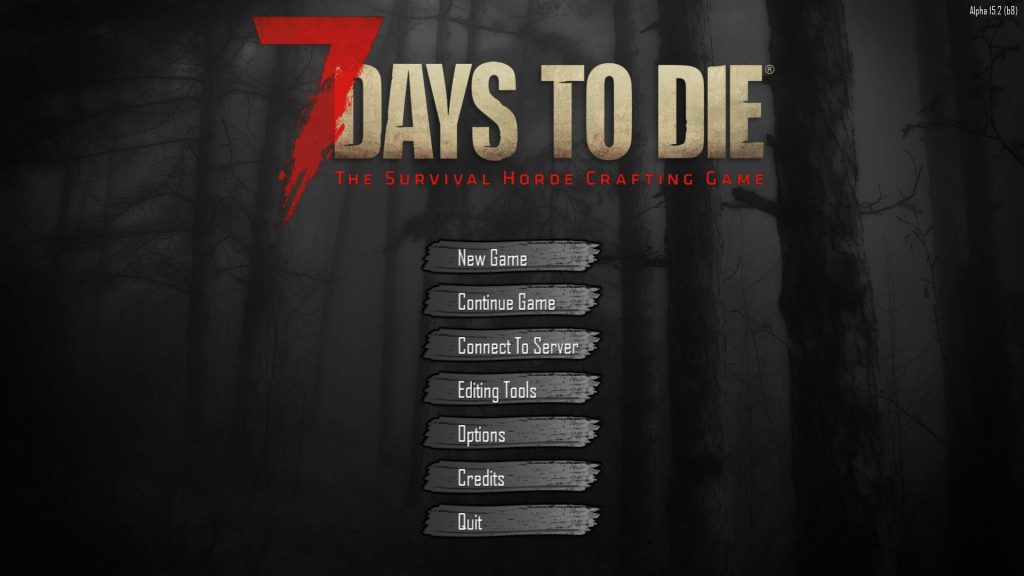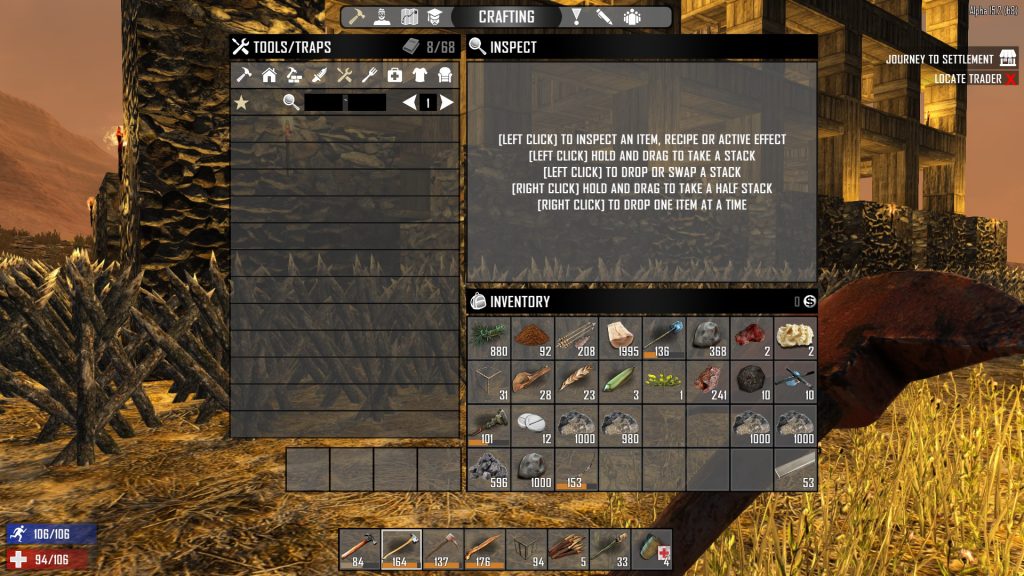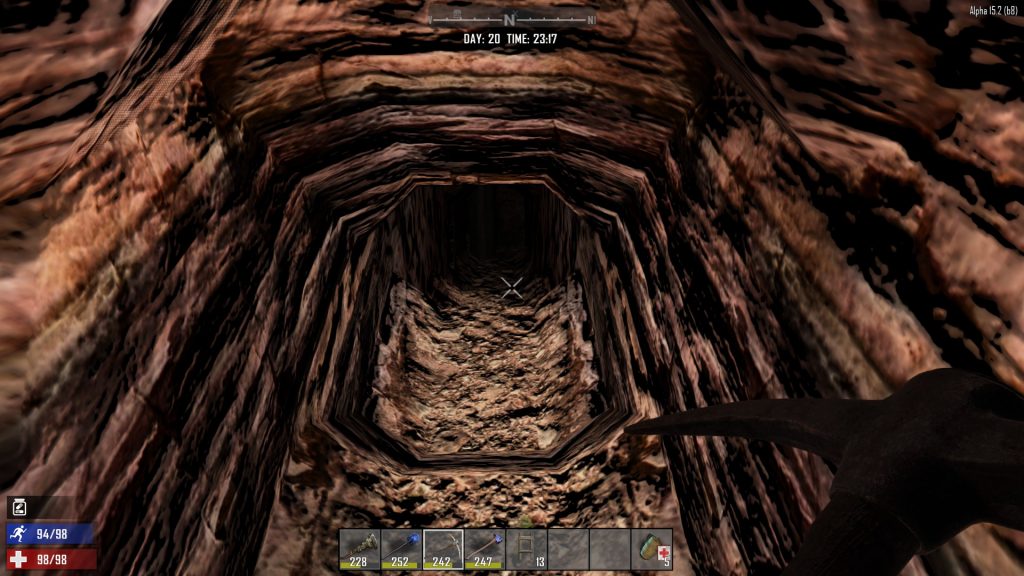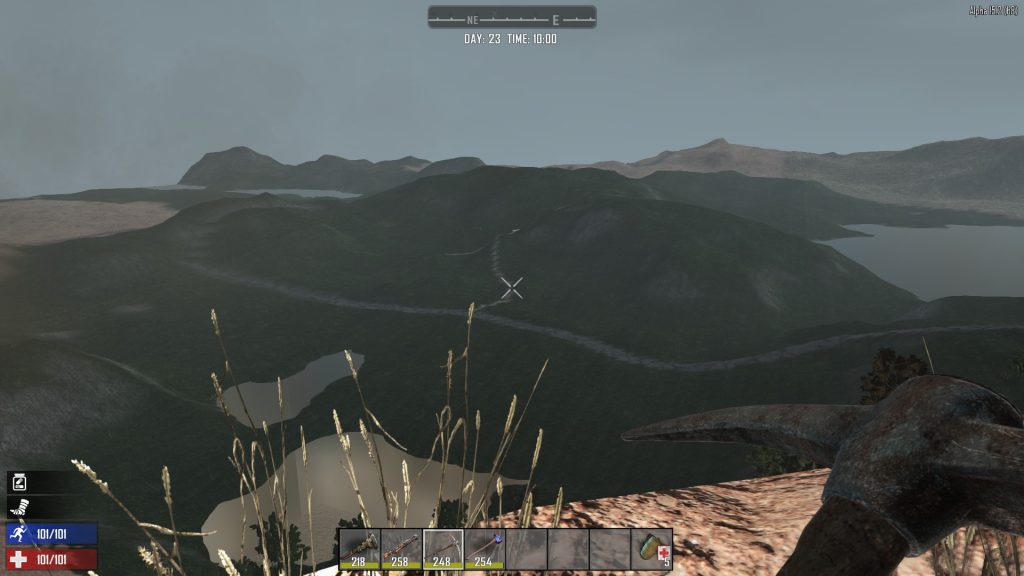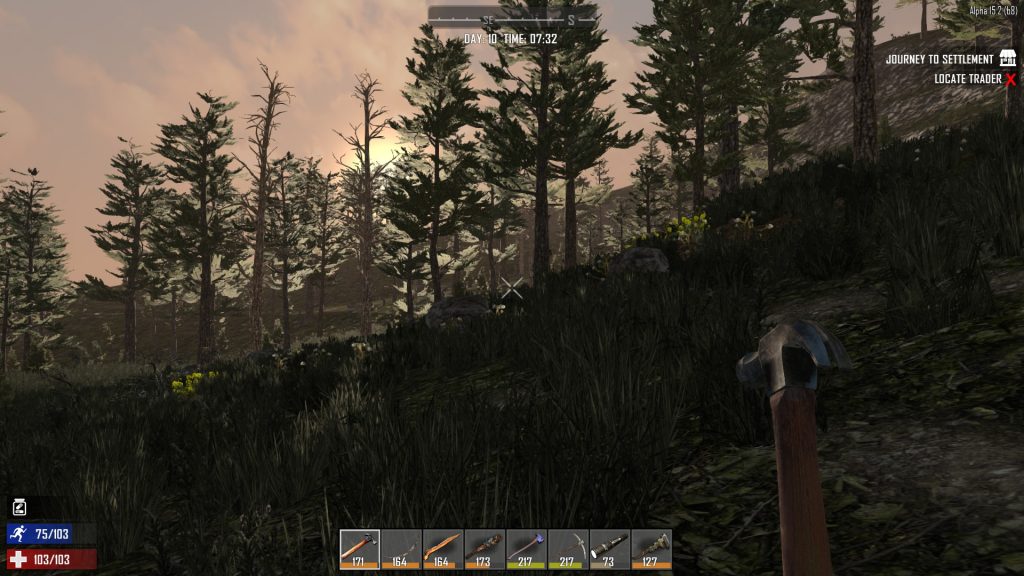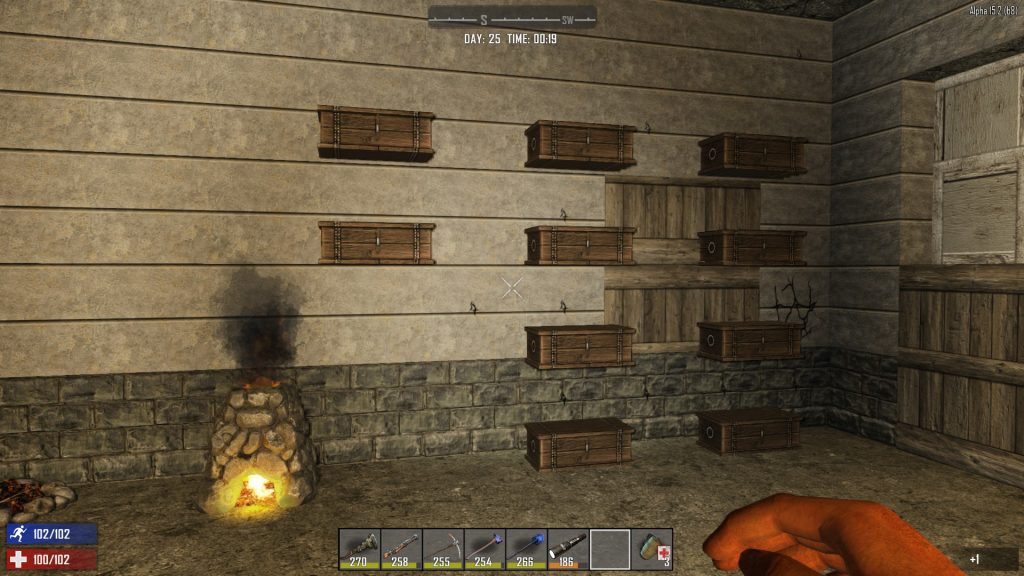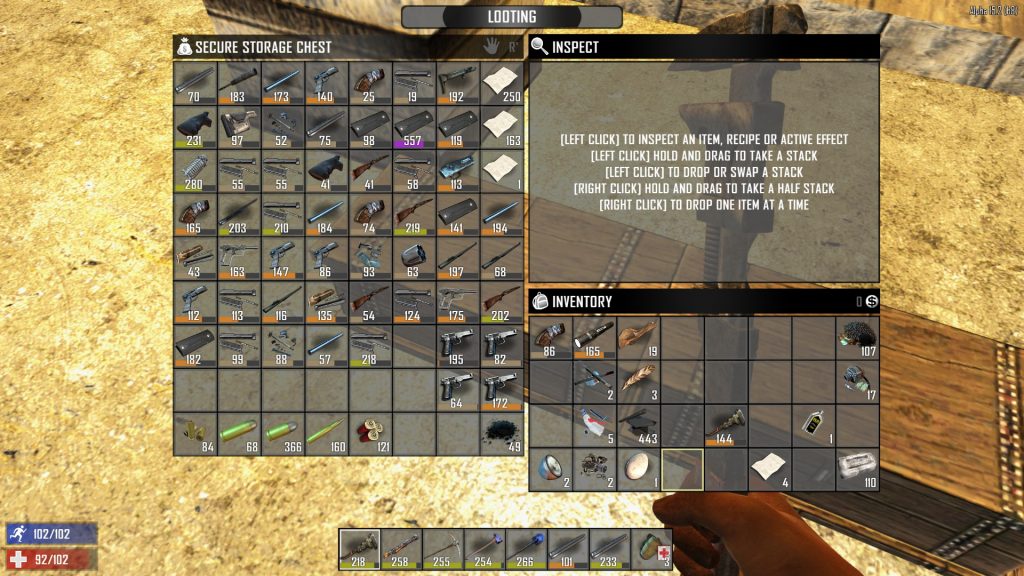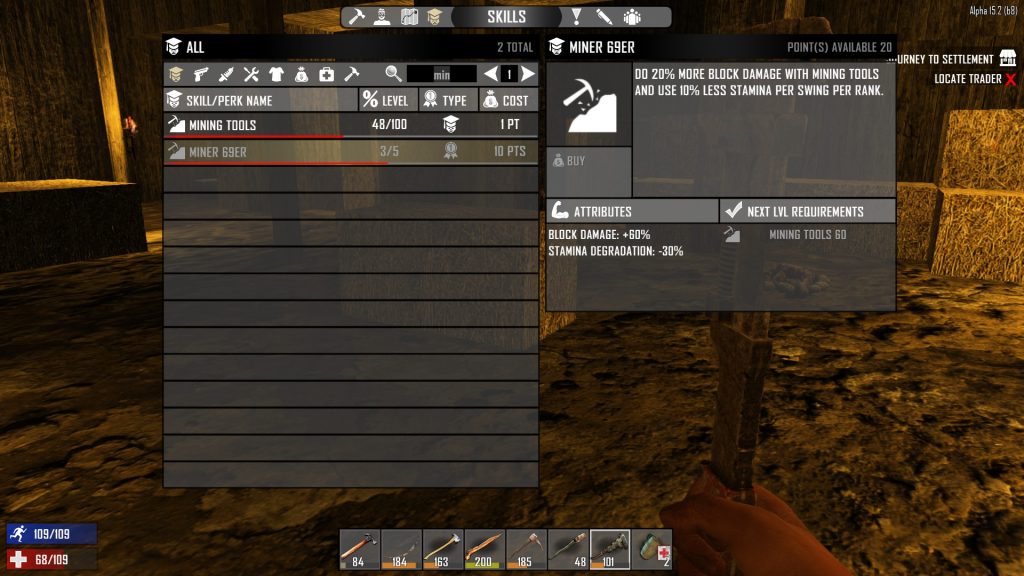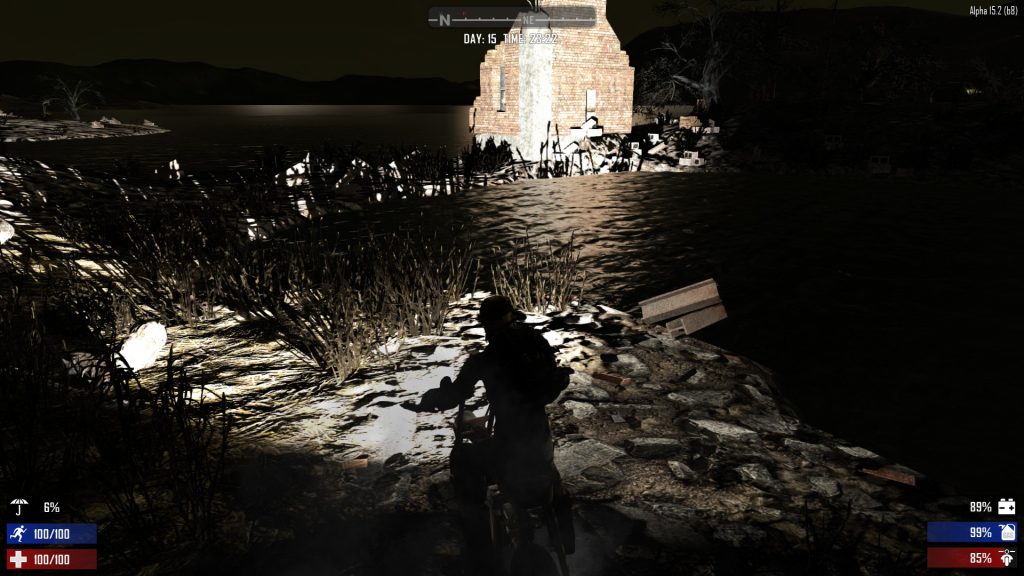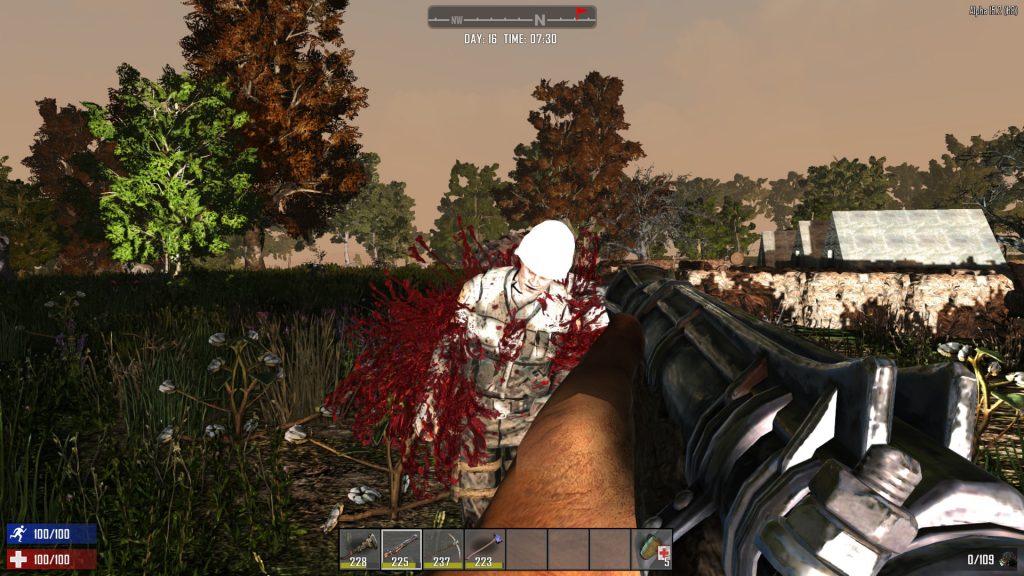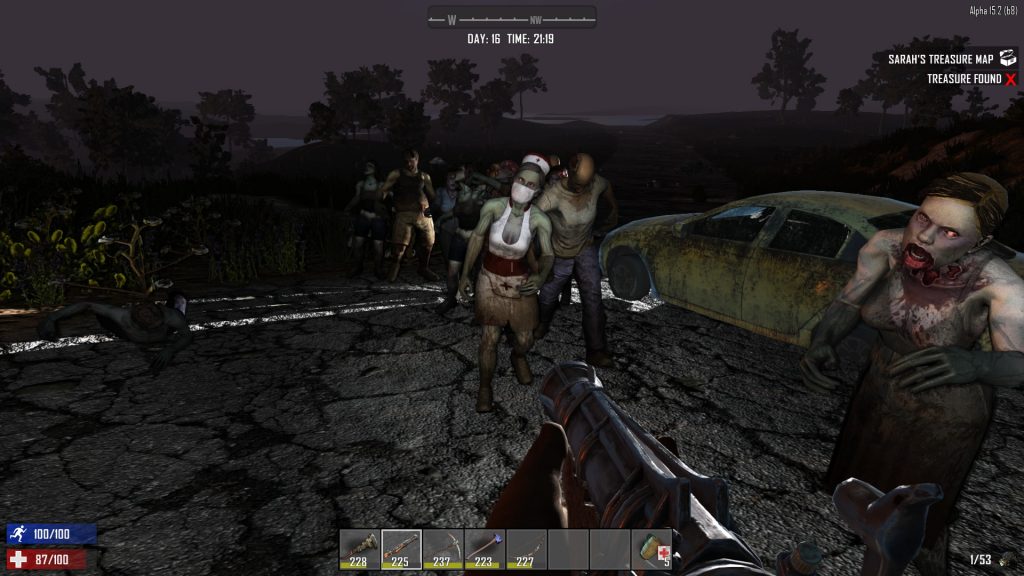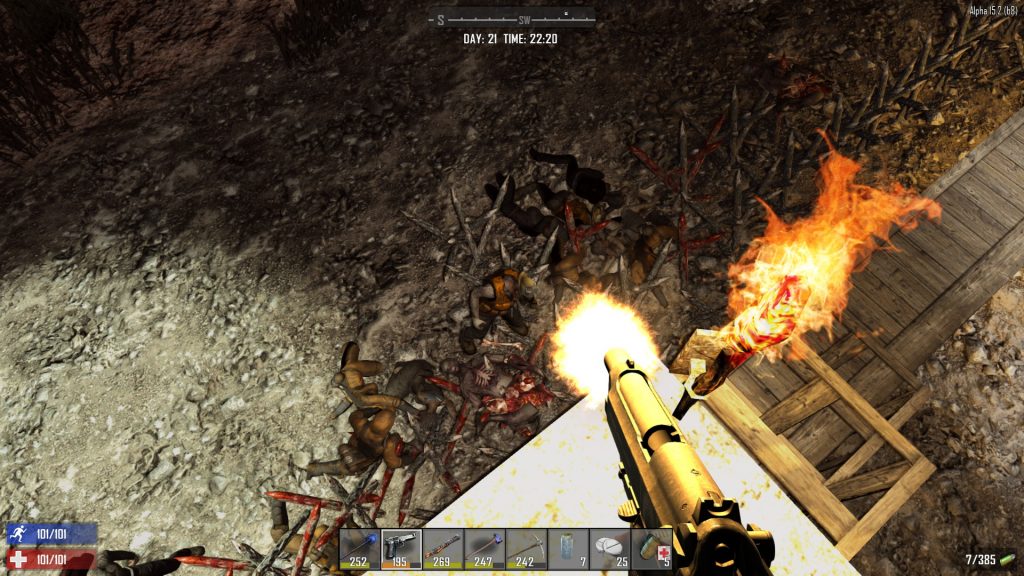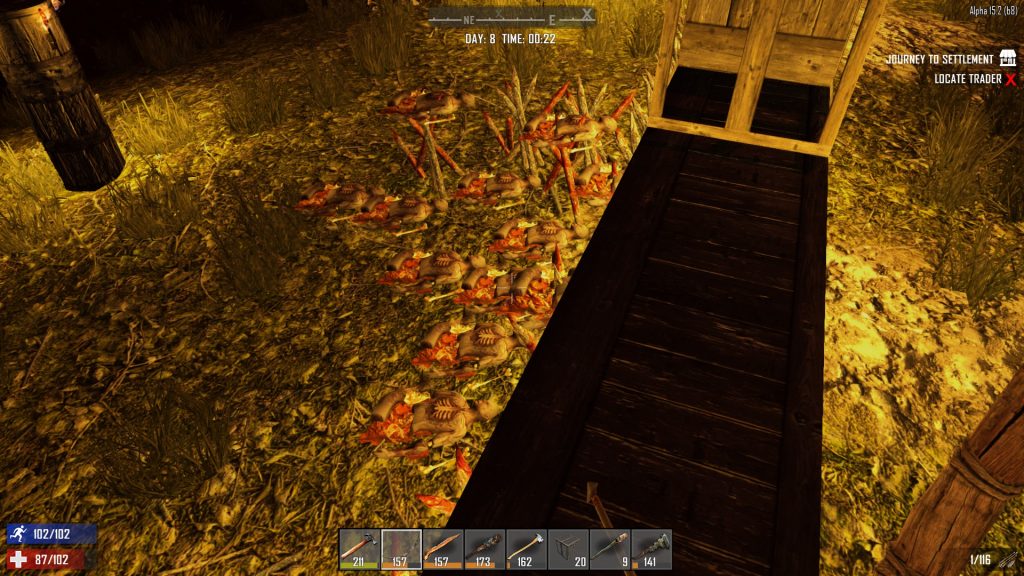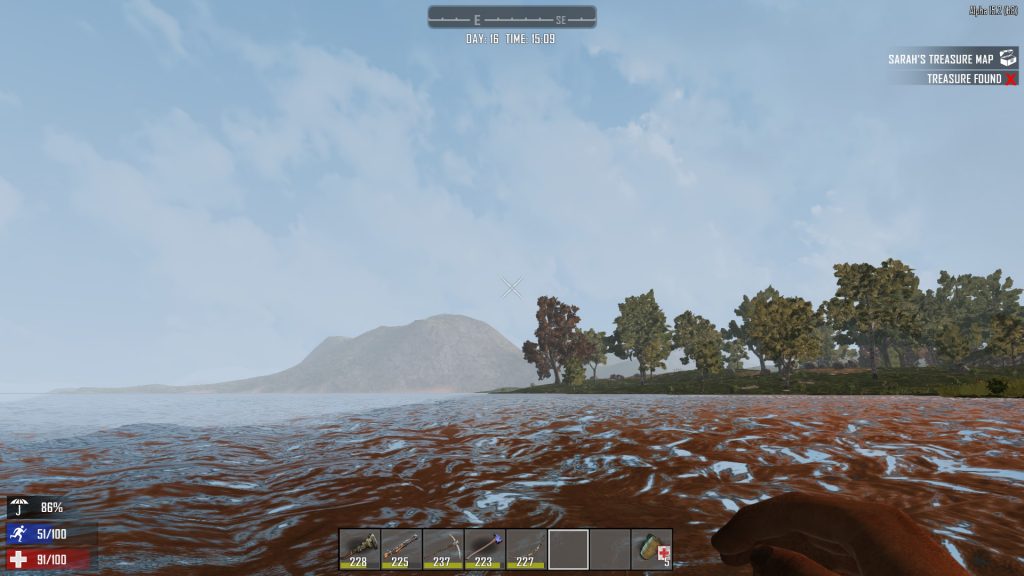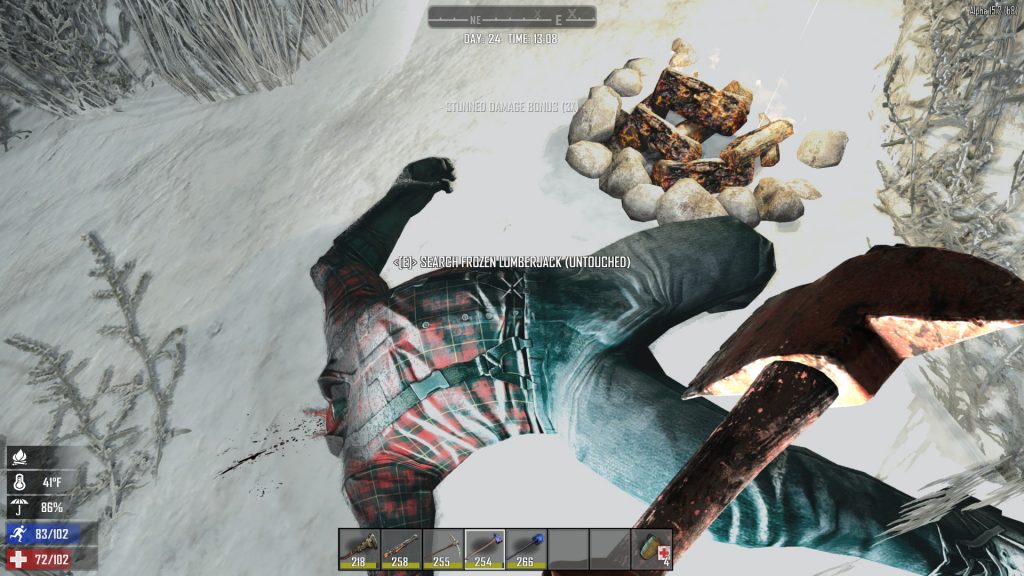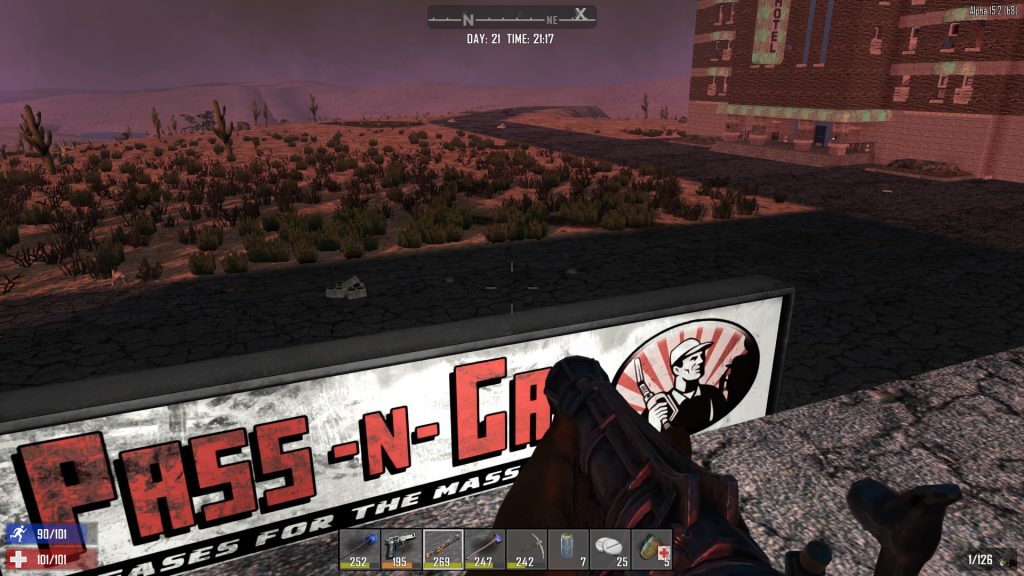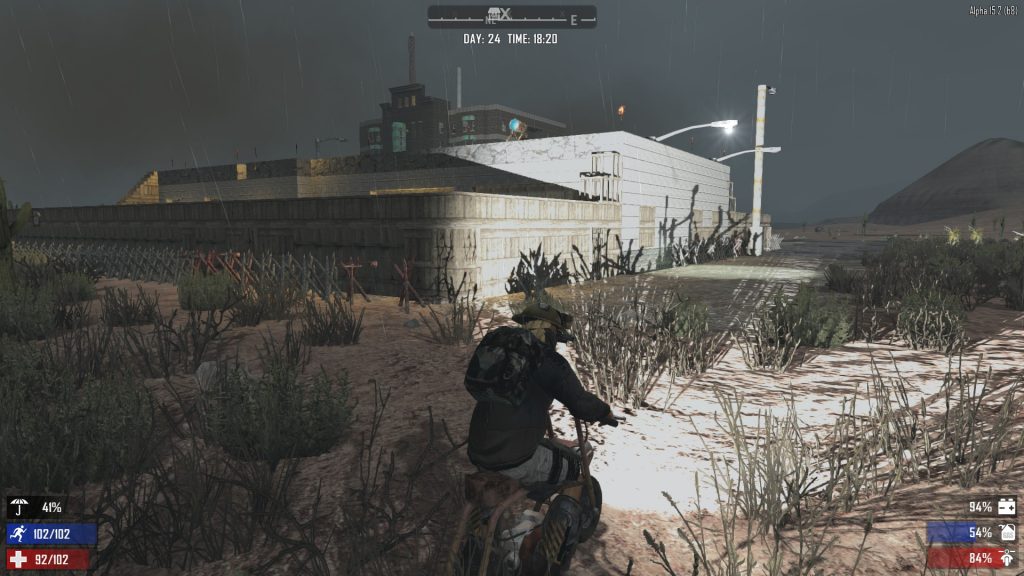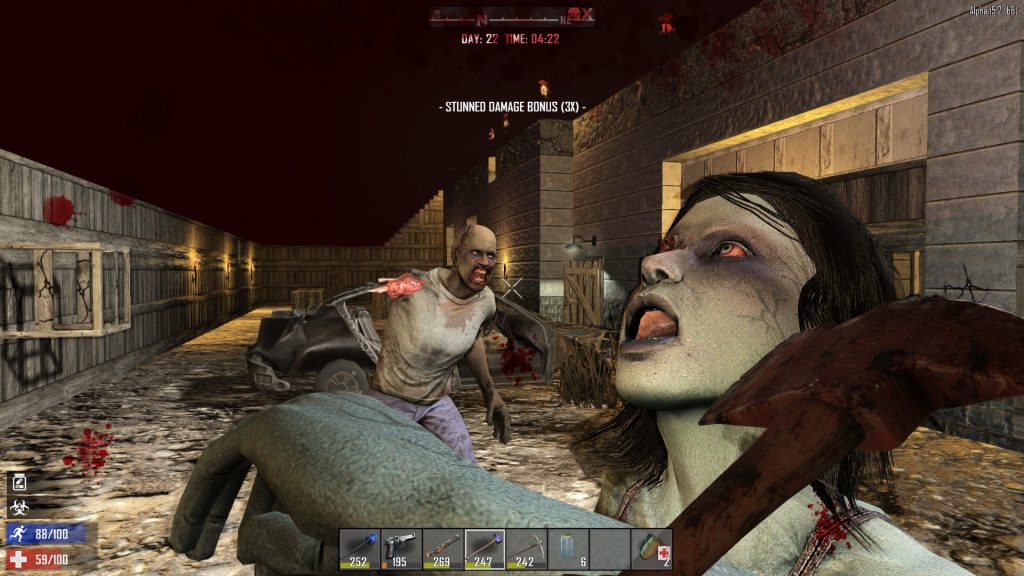*Note: To get straight to the review, skip the Foreward.
–Foreward–
There are those in the world that are architects. Put them in a room filled with Legos and they will construct a complex model of various structures, roads and buildings. There are some that are artists. Put them in the same room and they will build a clever work of art out of all the pieces available to them. Then there are people like me. People with the capacity to construct, but have no desire to do so on its own. People with the creativity to create, but lacking the motivation to do so without a purpose. You see, people like me need structure with purpose; creativity with function. If you put me in a room filled with Legos, you would soon find me creating rules, mechanical structure, objectives, goals, obstacles and enemies; leading to an ultimate confrontation hidden somewhere deep within the mystical Lego kingdom. Then I would invite some friends over to try it out. That’s where games like 7 Days to Die come in.
7 Days to Die is, yes, brace yourself: A zombie horde survival crafting game. Hoo boy. Fanfare galore. Go ahead; get your eye rolls and meta-groans out of the way, because honestly they are deserved. Oh Zombies you say? That’s a new cutting-edge market. A survival game? Never heard of that before. Wait–you can craft too? Wow, that’s really breaking the mold for modern gaming! …not. But the thing is, all of these concepts are good ideas, especially for gaming. There have been plenty of great games representing these genres that have been released within gaming history that not only deserved their accreditation when they were released, but still hold up today. The problem? Well, when something gets popular, a whole flock of uncreative brainless money-grabbers and fame-seekers rush over to it. They are those who are desperately trying to cling to or copy something they see with the belief that the ingredients form a 1:1 binary equation. Input X, Y and Z into your game, output cash and success. This wouldn’t be so bad if weren’t for the fact that customers tend to think the same way: input cash into a game that has X, Y and Z, output fun and enjoyment.
Eventually the market catches on and tends to move past whatever gimmick happens to be trending as through pattern recognition they inevitably become aware of the scheme (and those that remain ignorant have moved onto whatever peddler is flashing the next shiny thing into their dull faces) and we are left with a genre (or in 7DtD’s case, genres) that have their name sullied and tarnished. Battered, unloved and feeling a little used, the genres are left with either the arduous task of attempting to be used to create a game of expansive quality on a level that sets it apart from the horde of previous pretenders (a difficult task when paired up with the recipients, a once bitten twice shy and skeptical audience) or they close up shop in defeat, drowning in an over-saturated market.
So what exactly am I trying to say, and what does it have to do with 7DtD? Simply this: Zombie games are not inherently bad. Neither are games that involve crafting or survival. Likewise, Zombie games are not inherently good either. Neither too are games that involve crafting or survival. The content and quality of the game is dependent upon the work of the creator and the enjoyment of the recipient is dependent upon their tastes and expectations. So, when I say that 7DtD is a good game, I’m not saying it’s good because it has zombies. I’m not saying it’s good because you can craft cubes and survive through things like hunger and cold. I’m saying that it’s a room filled with Legos that serve a function. I’m saying it’s a giant world filled with little objectives and treasures. I’m saying it’s a good game and that game happens to contain elements which sadly have been overdone to the point where they have a poisonous reputation, created from all the chintzy knock-offs that use them as a positive front for poor design. 7 Days to Die is a fun game, but you must grade it on its own merit or else it risks falling into a sea of things that are charading as something like it.
–Review–
7 Days to Die is a great game. It has so much content and so many fun pieces to play with, that I’m not really sure where to start. For instance, I could say that it’s a great simulator for hiking and camping in the mountains. It’s also a great zombie-killin’ game with a nice variety of zombie archtypes, many with unique movement animations, “skills,” stats and aggression (to say nothing of the dogs and giant flies). It’s also a decent post-apocalyptic game, with radiation, scrap-metal constructions and the desire to hoard the most mundane of resources (including but not at all limited to human poo) because you can always Macgyver it into something great later on when you really need it. There are even trading posts set up and run by NPCs where you can trade in your Casino Tokens (the present currency, similar to caps in Fallout) for the odd piece of gear that you can’t find, although they of course hike the prices up.
Did I also mention that it’s an RPG? Nearly everything you do in the game has a level associated with it, and there are 22 skills and 31 perks. Don’t get me wrong, you probably won’t be picking “classes” when you level up (most of the skills/perks are good for anyone aside from the ones focused on specific weapons) but there is *always* something to look forward to leveling up, especially when you consider that the skills have 100 levels each, and many of the perks have multiple levels as well. Lastly, who could forget that the game is about building bases as well? While aesthetics aren’t the focus when it came to your building options, functional operation has not been spared, and you’ll have more than enough shapes, structures and pieces to build the kind of base you want, out a small but distinct variety of materials. 7DtD truly is one of those games where they wanted you to have your cake *and* eat it–and The Fun Pimps (developer) were able to pull it off by keeping things simple but solid.
… so what does a game of 7 Days look like?
To start out with, you’re given nearly nothing. A bottle of water, some food, a first-aid bandage and a single torch is all you’ve got. Oh, and your boxers I guess, although those can’t come off. From there it’s up to you to find a way to survive and scavenge your way to success. You’ll start off with stone tools and from there progress to iron and at the end steel. The progression itself isn’t so much important as it is that you find a safe and reliable way to maintain whatever protection you decide to stick with. Obviously, a steel axe will be better than a stone one, but it’s not like Minecraft. A single Steel Axe doesn’t mean a whole lot, and clever use of a stone axe against enemies will grant nearly the same results. You might be wondering, why upgrade at all? Well, there are boons all around, any time you upgrade a piece of equipment (be it the level of the equipment or the actual material that it was made of) but benefits are steady and don’t spike very hard, which creates a wonderful balance.
For example, you could forego safe play, rush to the point where you could forge your first iron axe and then equip and use it, but it wouldn’t mean very much. For starters, the quality would be extremely poor because your base Construction Tool stat would be very low. Additionally, your Mining Tool skill would be zero, and it would take a while before it boosted itself to make the use of the Iron Axe valuable (since it counts as a Mining Tool, but the Stone Axe does not). You also likely wouldn’t have gained enough actual character levels to have enough skill points to buy any of the mining tool perks, which is largely part of what makes the higher level tools much better. You must also consider that you have jumped straight from the Construction Tool Skill to the Mining Tool Skill, but there are a lot of other perks that you’ll want that require a 20, 40 or 50 Skill level in Construction Tools, meaning that at some point you’ll have to grind out the Con. Tool stat since you didn’t let it level up more naturally. *Whew.*
This is merely one instance of progressional balance in the game that make me so happy to play it. Take Minecraft for instance–the first thing I want to do when I play Minecraft is grab some coal. Why? So I can light up the caves and grab some iron. Why? So that I can dig down to the center of the earth and grab some diamonds. Why? Well because once I’ve done that, that’s it. The game’s progression is over. At the point where you obtain a diamond pick in Minecraft, it never really gets any better than that. There’s no more need for progressional thought; it just becomes a giant Lego game without meaning. 7DtD though? Lower quality equipment in the right circumstances can actually be better than the higher level stuff. Having good equipment on its own isn’t enough; you need to consider a slew of other obstacles that you need to confront. Add to that, that frankly, no one’s stopping you from going through the game in cave-man gear either. The same bow that you can craft right when the game starts is just as viable a weapon to play the entire game as is the crossbow. It can’t be said that the crossbow isn’t better–it’s just that it feels more like an upgrade or a reward instead of a necessity.
Back on track what a normal game may look like, let’s say you’re a week in and you’ve managed to construct yourself a forge for iron, scavenge some decent supplies and you’ve set yourself up a nice base. Well what then? Well, nighttime is generally scary at any point in the game. Not only is it just, well, harder to see anything, but Zombies become extremely aggressive and gain the ability to sprint, making it very easy to get caught off guard or even killed. It gets even better though, because true to the game’s name, every 7 days, a massive zombie horde hits you at night and continues to trickle in until sunup. That means it’s not only your job to survive during the week from the normal dangers, but the entire time you need to be building up for and thinking in the back of your head of what you need to do to survive the 7th day.
This is where you’ll need some creativity or possibly self-control though, as admittedly there are some flaws to this horde mechanic. You’ll quickly realize that there are some things you can do on the 7th day to nullify the attack. Digging to the center of the earth and blocking up the tunnel until morning is a boring, but viable strategy. There’s also the “really-tall-building” strategy. Normally, if a zombie finds that it can’t reach you, it will begin attacking the foundations of whatever structure is underneath your feet. This means that a lot of buildings aren’t safe on their own even if you climb up to the roof because the zombies will eat away at the building foundation until it crashes down. However, finding a very tall and structurally sound building (the hotel is a great example) and just sitting on top of it sort of gives the zombies nothing to do. You’re so high up (it’s like, what 8 stories?) that most of the zombies will get confused when they try to determine where they need to attack. Secondly, the Hotel is constructed of 3000 HP concrete blocks, which means that even if they do start attacking the building, it will take them all night just to chew through a meager few squares of it. Again though, waiting on top of the Hotel is kind of boring.
I quickly began looking for more exciting ways to survive the 7th Day, in a manner that I felt was more realistic to our favorite zombie medias. Sometimes I would take an old house or a gas stations a soup it up into a nice fort or outpost. Other times I’d find a complex ground-level building and open it up inside with twisting traps, spikes and fall-back points. If I was feeling ambitious, I’d simply build a base from scratch. Regardless, I found it to be the most enjoyable when I was in a position to actually fight the zombies on the 7th night, instead of waiting them out for 20 real-life minutes. This is something the player must do on their own, but I personally have a problem with that. I mean, to be fair, holing yourself away might actually work in a real zombie apocalypse. I don’t think Zombies actually *would* be able to break down a hotel building. Why don’t the people in zombie films use this strategy more often? I suppose they do but usually then they die of hunger or thirst because they get stuck on top.
Anyway, the 7-day rushes and the game overall becomes harder the longer you play it. You begin to build up a “heatmap” (an invisible metric of activity which draws zombies to your location) the longer you play. The game will also spawn a wider variety of zombies to attack you which are arguably stronger than the starting cast (spider zombies are the worst) and eventually mini-hordes start to spawn and attack you, even on days that aren’t the 7th. This means that you’ll always need to have a good weapon, a few healing items and an escape plan in mind wherever you are, in case things go pear-shaped.
Elements are a part of the game as well. Remember what your momma told you–if it’s hot drink plenty of fluids and if it’s cold don’t go outside without your jacket. Water saturation also can be a big deal–if it’s hot, you’ll want to jump into the lake to cool yourself off. If it’s cold and you’re already wet, you’ll want to start a fire to dry yourself out. You also can’t just drink any ol’ water either, unless you like dysentery which brings along a whole other set of problems. The Zombie virus is a threat too; get tagged by a zombie and you might contract it. It doesn’t take much of a toll at first but if it remains untreated it will really sap your ability to do much of anything that relies on the Stamina stat.
Depending on what you want to focus on, your late-game can include a variety of toys to play with. You can assemble a motor bike from parts scavenged from old cars (and continually upgrade it as you find more pieces). You can farm nearly any unique plant in the game. You can cook more complicated meals in an attempt to raise your max HP/Stamina. You can become a scientist and craft things like gunpowder or gasoline. You’ll always want to scour the land for recipes and instruction books which will teach you how to craft armor, weapons and assemble the pieces of guns that you find lying about. You can build industrial light fixtures from scavenged parts if you don’t like torchlight. You can chase after airplane supply drops that soar overhead every now and then. If you want more of a game-given objective, you can even accept challenge quests where you have to hunt down and kill certain zombies, or treasure quests where you try to locate buried treasure.
For me though, the most fun part was discovering new cool places. Sometimes you’ll find abandoned houses out in the middle of nowhere. You might stumble upon the odd gas-station or shop at a street intersection. When you do find pockets of “civilization,” they come in two exciting varieties; either a network of community buildings, each abandoned from their original purpose, or a labyrinth of shelled-out buildings in a desolate wasteland. Either way, it was always fun to run in and discover what secrets they held. School community building? A great place to find clothing supplies. A strange shed? Breaking the odd panels on its floor revealed a bomb-shelter. An office building? You know those chairs contain delicious Leather and Mechanical Parts that I need for my workbench. I think what I love the most about it is that it turns the mundane into a treasure trove.
It’s probably best if you play the game with some kind of goal in mind. If you try to play it to “win” then you’ll wind up disappointed, as you’ll have found yourself investing hours into a game that doesn’t have some sort of villain at the end, or a secret Illuminati cult for you to topple. You’ll need to play the game thinking “I’m going to make an awesome base” or “I’m going to create a giant farm” or I’m going to create a motor bike and become a nomad, never using a base (saw that one on a Steam thread). For me, I played the game as a roguelike. Any time I died, I erased the world (and by extension the character attached to it). This made the survival aspect hit really hard. I couldn’t play fast and loose in the military minefield. I *always* needed a backup plan in every situation. Playing it safe was mandatory. In the end, I really enjoyed it. As I write this, I’m coming off of finally obtaining the “Nearly Immortal” achievement, which is awarded upon surviving for 1250 minutes (25 in-game days) without dying. In spite of 200+ hours into the game… I still want to go back and continue playing it. There are so many things left undone.
Ultimately, if you don’t like zombies, crafting, surviving, or any of the aspects listed here, you won’t like the game. If you want a game with an explicit purpose, an “end-game” or a “win condition” then you shouldn’t play this game either. However, if you like taking things slow, outside scenery, post-apocalyptic survival, steady progressional play, base-building and having the ever-present excitement of the undead at your doorstep, then truly, do yourself a favor and try this one out. It is somewhat time-consuming, but once you learn how things work it the reward on investment is worth it. Easily this game falls into the Tier 1 category… and did I mention it’s in Alpha? They’re releasing version 16 soon. If I’ve spent this much time on an unfinished project… how much better will this game be as the years pass? Much better, that’s how much. Because no one ever ruins games when they update them. Ever, ever. Right?
